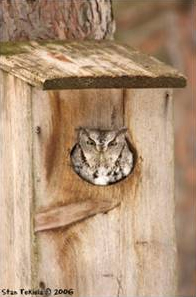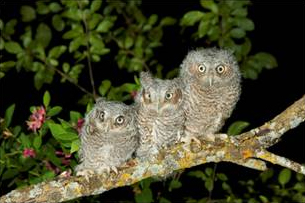View all of the titles in the
NatureSmart Bookstore


by Stan Tekiela
© NatureSmart
May 25, 2007
Ask anyone who knows me and they will tell you that I love all birds but there is one special group of birds that I stand partial towards--the owls. For as long as I can remember owls and other raptors have held a special place in my naturalist heart. I have traveled thousands of miles and hiked many miles more to see and photograph owls all over this country. They are just one of those birds that really excite me.
I am not the only one who finds owls captivating. I know many who are just as enthralled as I am with these birds. One of the things that I find so interesting about owls are that some species are so tiny such as the Elf Owl which is only 6 inches tall while others are so large such as the Great Gray Owl which stands over two feet tall. Even though there is a large size difference these owls share many common features.
For the past two years I have been fortunate enough to be able to do an in-depth study and photograph, with the aid of some modern technology, of a nesting pair of Eastern Screech Owls. These small owls have been very accommodating and tolerant of my efforts to learn more about their behavior.
It all started last year when a wonderful retired couple contacted me to stay they had an owl roosting in one of their Wood Duck boxes. It was late winter so I stopped by to take a look. Sure enough an Eastern Screech Owl (gray morph) had taken up winter residency in one of the wood duck boxes. On sunny days she would sit with her face out of the hole allowing me several nice opportunities to photograph it.
Later, towards spring a second owl, this time a red morph, showed up and was also roosting in a near by nest box. The home owner and I went around and looked in all the nest boxes to determine which one they where using for nesting. We installed a tiny infra-red camera that is capable of seeing in the dark in the nest box. We ran a wire from the nest box into the home and hooked it up to the VCR and TV. Just like that we had a window into the private life of this pair of owls.
It wasn’t long before the female started laying eggs. We watched as each day she would lay another ping-pong sized and shaped egg until she had a total of four eggs. Over the next month we watch as she preformed what I think is an amazing feat—incubating the eggs. Incubating may seem like a simple and mundane process but in many respects it’s another example of how amazing mother nature can be. Think about it; if “you” sat down for a month, as this bird does, with only a few minutes break each day, your muscles would atrophy (weaken) to the point where you would need to learn how to walk all over again.
During this month long incubation the eggs need to be kept near 99 degrees F which is a degree warmer than our own body core temperature. Owls average around 104 F body core temperature. The female does all of the incubating. The male will bring her food which she sometimes carries off to consume someplace else or will stay in the box to eat.

Twenty six days after she started incubating the camera showed us the hatching of the four owl chicks. As each egg hatched the mother eat the egg shells presumably to regain the calcium that she lost while producing the eggs. Each tiny owl chick comes into this world with its eyes sealed shut and sparsely feathered. The mother continues to sit on the chicks to keep them warm. This is called brooding. For the first week or so of their lives the tiny owls have no ability to regulate their body temperature so brooding is extremely important. If the chicks become cold they will be too weak to lift their heads and feed. Without feeding they will become even weaker and cool off even more and will soon die.
The male brings the female and the chicks their food. He flies up to the nest box and quickly deposits whatever morsel he has caught into the nest hole. Usually it is a large insect such as a moth, but he also brought in many mice and small birds. Each food drop is accompanied by a lot of calling by the female.
Night after night he faithfully brings in enough food for the chicks and the mother. The mother tears up the food items and feeds the hungry owlets. After only a week the female leaves the box and the young start to feed themselves on whatever the parents drop into the box. By the third week the young have grown enough to leave the safety of their nest box and join the world.
We were extremely fortunate enough to have the same pair of birds return to the same nest box this year but this time laid six eggs. Again with the aid of the infra-red camera we watched. Tragedy stuck when during one of the nights when we were not watching four of the six eggs went missing. We don’t know if it was a raccoon but that is my guess. Shortly after the two remaining eggs hatched. We were thrilled again.
I still see each bird hatching as a miracle
and this year was no different. As I write this
the two young owls are growing and stretching
their wings in preparation for their first flight
out of the box. Once again I feel as proud as
the owl parents. Until next time...
The nationally syndicated NatureSmart Column appears in over 25 cities spanning 7 states: Minnesota, Wisconsin, Michigan, Illinois, Ohio, New York and Pennsylvania. It is a bi-weekly column circulated to over 750,000 readers.
Wolves
Just the day before, a pack of wolves known as the Wapiti, had found a large bull bison that was weak and injured. Based on its size, this big boy was near the end of its lifespan and the winter weather was taking its toll. For a full day the wolves tried to approach the bison but when the bison...
Moose
It was one of those dark and cloudy winter days in Yellowstone National Park where the clouds are so heavy and low, you feel like you can reach up and touch the cloudy sky. A light wind helped to blow the falling snow with occasional gusts of wind causing swirls of fluffy white snow...
American Badger
It’s funny, I believe the average person knows more about the Honey Badger (Mellivora capensis), a critter of Africa and Southwest Asia than they do about the badger in our own backyard, the American Badger (Taxidea taxus). Social media has a lot to do with the Honey Badger phenomena and...
Backyard Bird Feeding
Winter bird feeding is one of the most common / popular hobbies in America. It is estimated that nearly 60 million Americans feed birds in their yards in winter or summer. That is about 40 percent of all American’s make backyard bird feeding part of their everyday activities. It’s...
View all of the titles in the
NatureSmart Bookstore
Check out Stan's latest photos at
NatureSmart Wildlife Images
Take a tour with Stan.
» More Info
Hear Stan on radio stations all across the Midwest.
» More Info

When he's out in the field, Stan relies on his Vortex Razor binoculars and Vortex Razor spotting scope to help find the subjects for his award winning wildlife photography.

For thirty years, professional wildlife photographer Stan Tekiela has counted on Hunt's Photo and Video to provide him with professional photography equipment.
From tripods to camera bodies and lenses, Hunt's has been Stan's place for everything that he needs. Personal service and prompt shipping means Stan can count on Hunt's to support his professional wildlife photography career.


Professional Wildlife Photographer Stan Tekiela always uses Feeder Fresh in his seed feeders to help keep the feeders and food dry, clean and mold free.
He also uses Feeder Fresh Nectar Defender in all of his hummingbird feeders. It safely keeps nectar fresh longer.